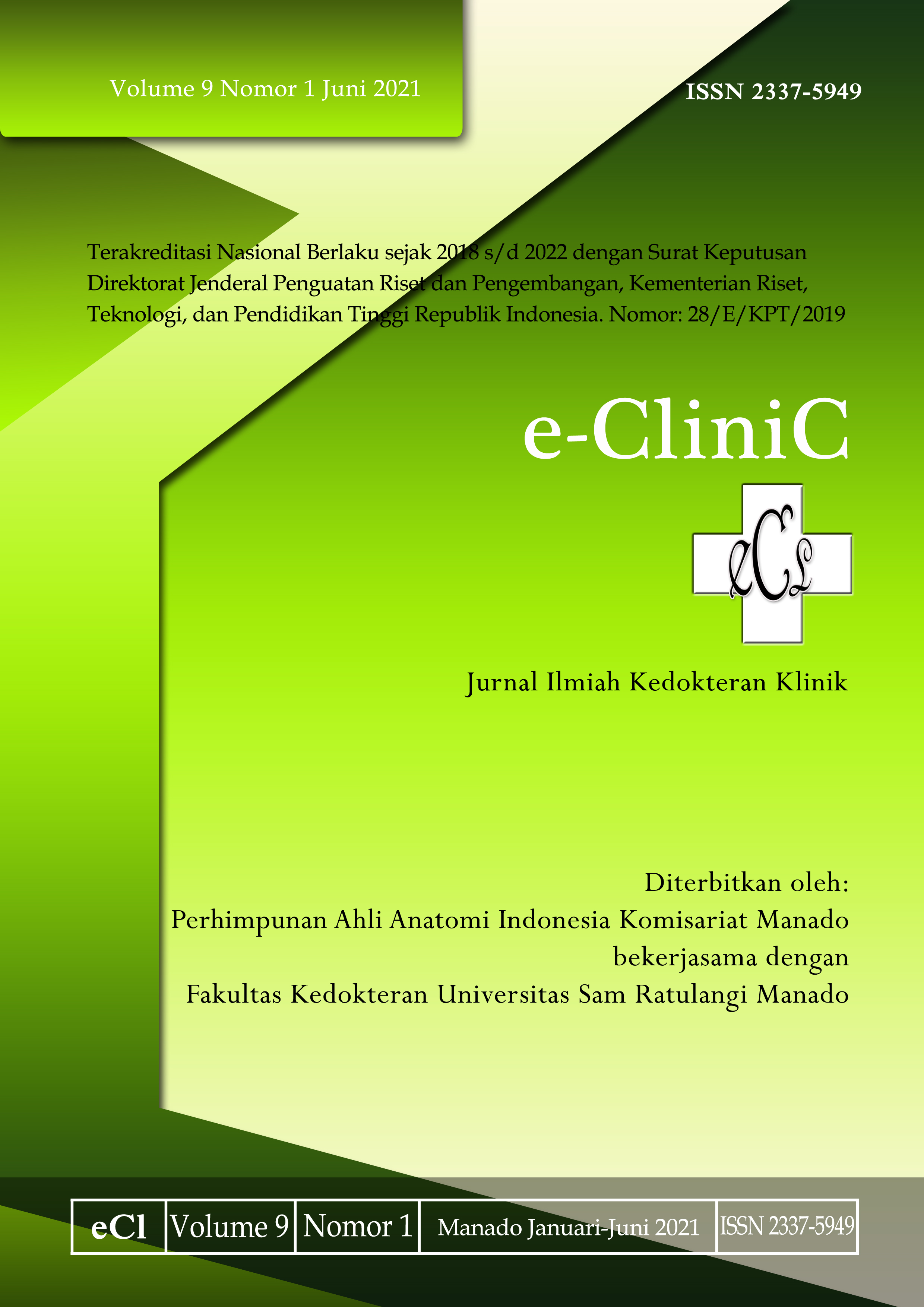Gejala Klinis dan Pemeriksaan Penunjang pada Neonatus Terinfeksi COVID-19
DOI:
https://doi.org/10.35790/ecl.v9i1.32304Abstract
Abstract: COVID-19 is spreading at an extremely rapid rate and can affect all age groups, albeit, information about clinical symptoms and laboratory examinations of COVID-19 I in neonates is still quite limited. This study was aimed to determine the clinical symptoms, radiographic examinations especially CT-scans, and laboratory tests that could appear in neonates suffering from COVID-19. This was a literature review study using three databases, namely Pubmed, Clinical Key, and Google Scholar. The keywords used were Covid-19 / SARS-CoV-2 AND Neonatus AND sign and symptoms AND laboratory. The selection based on inclusion and exclusion criteria, obtained 15 case report studies, three retrospective studies, one observational study, and one cohort study. The review revealed that the most frequent clinical features that appeared were fever (54.8%), dyspnoea (35.4%), and cough (29%). Meanwhile, for CT-Scan radiographs, there were 14 of 31 neonates (45.2%) did not show any abnormalities or normal. The most frequent abnormal image was ground glass opacity (GGO) (29%). Among laboratory examinations, lymphopenia was the most common abnormality (32.2%). Moreover, leukocytosis, leukopenia, thrombocytopenia, increased PCT, AST, etc. could also occur. Of all the reviewed literatures, there were no death cases of neonates died due to COVID-19. In conclusion, fever, dyspnea, cough, and lymphopenia are the most common findings as well as GGO in the CT-Scan radiograph.
Keywords: COVID-19, neonates
Â
Abstrak: COVID-19 menyebar dengan sangat pesat dan dapat menjangkiti semua kelompok usia namun informasi mengenai gejala klinis dan pemeriksaan laboratorium terhadap kelompok neonatus masih terbatas. Penelitian ini bertujuan untuk mengetahui gambaran klinis, pemeriksaan radiografi khususnya CT-Scan, dan pemeriksaan laboratorium yang bisa muncul pada neonatus dengan COVID-19. Jenis penelitian ialah literature review dengan pencarian data menggunakan tiga database yaitu Pubmed, Clinical Key, dan Google Scholar. Kata kunci yang digunakan yaitu Covid-19/ SARS-CoV-2 AND Neonatus AND sign and symptom AND laboratory. Hasil seleksi berdasarkan kriteria inklusi dan ekslusi mendapatkan 15 penelitian case report, tiga retrospective study, satu observational study, dan satu cohort study. Hasil kajian menunjukkan bahwa gambaran klinis yang paling sering muncul ialah demam (54,8%), sesak (35,4%), dan batuk (29%). Pemeriksaan radiografi CT-Scan, neonatus yang tidak menunjukkan kelainan (normal) terdapat pada 14 dari 31 neonatus diamati (45,2%), sedangkan kelainan yang sering muncul ialah ground glass opacity/GGO (29%). Pada pemeriksaan laboratorium, limfopenia merupakan kelainan tersering (32,2%), sedangkan leukositosis, leukopenia, trombositopenia, peningkatan PCT, AST, dll juga bisa terjadi. Dari semua literatur yang dikaji, tidak ditemukan kasus kematian neonatus akibat COVID-19. Simpulan penelitian ini ialah gambaran klinis yang paling sering muncul pada neonatus ialah demam, sesak, dan batuk, limfopenia, dan GGO pada CT-Scan.
Kata kunci: COVID-19, neonatus
Downloads
How to Cite
Issue
Section
License
COPYRIGHT
Authors who publish with this journal agree to the following terms:
Authors hold their copyright and grant this journal the privilege of first publication, with the work simultaneously licensed under a Creative Commons Attribution License that permits others to impart the work with an acknowledgment of the work's origin and initial publication by this journal.
Authors can enter into separate or additional contractual arrangements for the non-exclusive distribution of the journal's published version of the work (for example, post it to an institutional repository or publish it in a book), with an acknowledgment of its underlying publication in this journal.
Authors are permitted and encouraged to post their work online (for example, in institutional repositories or on their website) as it can lead to productive exchanges, as well as earlier and greater citation of the published work (See The Effect of Open Access).







